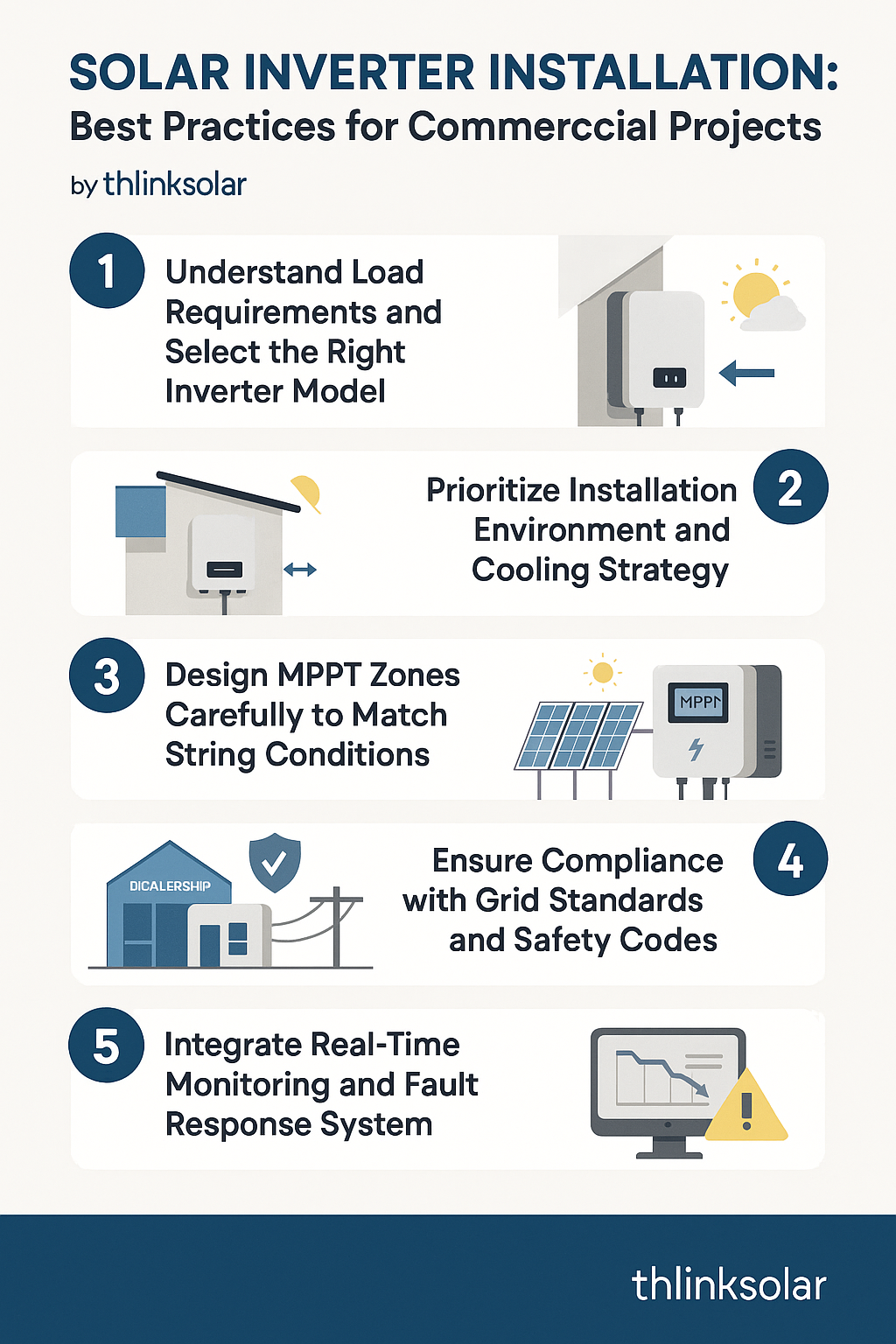

Solar Inverter Installation: Best Practices for Commercial Projects
Installing solar inverters for commercial projects is a high-stakes task. One misstep—whether in design, wiring, or environmental planning—can lead to lost power yield, frequent shutdowns, or even safety hazards. This article dives into thetop five best practicesthat experienced EPC firms and solar engineers use to ensure success—based on real installations, not theory.
1. Understand Load Requirements and Select the Right Inverter Model
Pain Point: Many installers underestimate load variability in commercial operations. From warehouse lighting to heavy machinery, demand fluctuates by the hour.
Solution: Before choosing an inverter, perform a full load profile analysis and ensure the inverter canhandle both peak loads and voltage fluctuations. For example, thlinksolar's hybrid inverters include wide input voltage ranges and overload protection—ideal for commercial buildings with irregular demand.
Tip: Always match inverter type (string, central, or hybrid) with system scale and backup needs.
2. Prioritize Installation Environment and Cooling Strategy
Pain Point: Inverters in hot or enclosed areas are more likely to overheat, triggering derating or shutdown.
Solution: Follow theIEC 60364-7-712standard for environmental design. Install inverters in shaded areas with at least30 cm of clearance on all sides. If indoor placement is necessary, provide active ventilation or air conditioning.
According to a report by SolarPower Europe (2024), inverters installed with proper cooling systems maintainup to 8% higher efficiencyover five years.
3. Design MPPT Zones Carefully to Match String Conditions
Pain Point: Mismatched panels across MPPT inputs cause energy clipping and underperformance.
Solution: Group PV modules by tilt and azimuth into separate MPPTs. For rooftops with shading issues, opt for inverters withmulti-MPPT inputsandPID protection. thlinksolar’s commercial series offers up to 4 independent MPPTs for optimal power harvesting.
Scenario: A logistics center with north/south-facing roofs avoided 12% annual energy loss by segmenting MPPT inputs by string orientation.
4. Ensure Compliance with Grid Standards and Safety Codes
Pain Point: Failing to meet grid interconnection requirements can result in costly delays or denied approval.
Solution: Confirm your inverter meets local codes such asIEEE 1547,EN50549, orUL 1741 SA. Install protection components likeanti-islanding relays, DC disconnects, andSPD surge arresters. Usecertified installersto pass inspections on the first attempt.
thlinksolar inverters are pre-certified for global utility standards and include built-in smart protections.
5. Integrate Real-Time Monitoring and Fault Response System
Pain Point: Undetected inverter faults or inefficiencies can quietly eat away at ROI.
Solution: Deploy inverters withcloud-based monitoring(Wi-Fi, RS485, Ethernet) and remote alarm settings. Enable features likeIV curve diagnosisandperformance benchmarking.
thlinksolar’s monitoring platform alerts technicians in real-time, improving response speed by up to 60% compared to offline systems.
Frequently Asked Questions
Q1: How long does a commercial solar inverter typically last?
Most commercial inverters last10 to 15 years, but regular maintenance and temperature control can extend lifespan by another 3–5 years.
Q2: Can I use residential inverters for small businesses?
Not recommended. Commercial setups require more robust protections, multiple MPPTs, and higher load handling. Choose inverters rated for commercial use.
Q3: How often should inverters be checked?
Quarterly visual inspections andannual full diagnostics(thermal imaging, firmware checks) are standard. Monitoring systems can reduce manual checks.
Q4: What is the biggest cause of inverter failure?
Overheating and poor wiring are the most common. Improper placement or skipping surge protection can also cause early failures.
Take Installation Seriously—Your ROI Depends on It
Solar inverters are theheartbeat of every commercial solar system. Skipping best practices leads to costly inefficiencies, utility rejection, or even system failure. But when installed correctly—with proper thermal planning, MPPT zoning, safety compliance, and monitoring—your system will deliver decades of clean power.
thlinksolar works with commercial partners worldwide to providecertified, high-efficiency invertersfor warehouses, manufacturing plants, office complexes, and more.
Ready to upgrade your installation strategy?
Explore our product range on thehomepageorcontact usto speak with a technical consultant.




